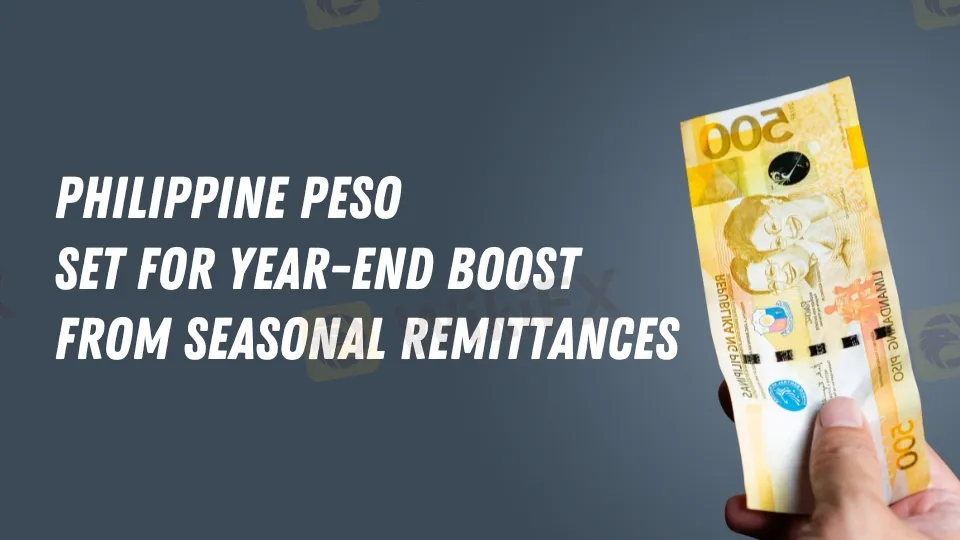简体中文
繁體中文
English
Pусский
日本語
ภาษาไทย
Tiếng Việt
Bahasa Indonesia
Español
हिन्दी
Filippiiniläinen
Français
Deutsch
Português
Türkçe
한국어
العربية
Philippine Peso Set for Year-End Boost from Seasonal Remittances
Abstract:The Philippine peso anticipates a year-end recovery driven by strong remittances, lower oil prices, and easing dollar strength amid the holiday season.

The Philippine peso, which has been under pressure since October, is likely to recover before the end of the year, owing to a seasonal rise in overseas Filipino worker (OFW) remittances. As Christmas approaches, these remittances normally increase, bolstering the value of the peso. This tendency has occurred in six of the previous seven years, and experts predict a similar conclusion in 2024.
According to the Australia and New Zealand Banking Group (ANZ), the peso might rise by more than 5% by the end of the year. The euro has fallen almost 4% this quarter, but experts believe it will reverse. According to Michael Ricafort, chief economist of Rizal Commercial Banking Corp., the peso will rise by around 4% by December. He observes that this seasonal stream of remittances, together with lower world oil prices, provide natural support for the peso.

Remittances reached $33.5 billion in 2023, making it one of the Philippines' most important foreign currency sources. These inflows provide a significant buffer for the peso and may offset the current decline that has driven the currency approaching a record low versus the US dollar.
Furthermore, any rate reduction by the US Federal Reserve may help the peso.
The Philippines is strongly reliant on fuel imports, therefore the drop in world oil prices is especially important. Lower oil prices aid in the reduction of the country's trade imbalance, relieving pressure on the local currency. The peso rose 0.8% this week, trading at 58.26 versus the US dollar.
However, others are concerned about the dollar's potential strength in the face of shifting US policy. Furthermore, future remittances from the United States may be influenced by changes in immigration rules. Nonetheless, experts observe that the Philippines' lower inflation rates and positive balance of payments provide a favorable environment for the peso's rise until the end of the year.
Khoon Goh, director of Asia research at ANZ, believes the peso will rise to 55.5 per dollar by December.
Final Thoughts
As the Christmas season approaches, the Philippine peso is expected to benefit from increased remittances and reduced oil costs. While certain dangers remain, a healthy balance of payments and low inflation indicate that the peso is on pace for a year-end rebound, offering hope for the Philippine economy in the face of global uncertainty.

Disclaimer:
The views in this article only represent the author's personal views, and do not constitute investment advice on this platform. This platform does not guarantee the accuracy, completeness and timeliness of the information in the article, and will not be liable for any loss caused by the use of or reliance on the information in the article.
Read more

5 Risks associated with Grand Capital
You can avoid fraud, crypto scams, and similar traps simply by staying informed. If you regularly follow forex news, there’s a lower chance that you’ll fall victim to such scams. Being aware is the only way to stay safe. That’s why you also need to know about the Grand Capital broker and why it should avoided.

Avoid Trendify: 5 Red Flags Revealed
Trendify is nothing more than a scam broker. It is one of those forex brokers that acts genuine but is actually full of red flags. Before you invest and fall victim to its investment scam, its better to check out the risks involved with Trendify.

10 Unlicensed Brokers Exposed – Check Now to Stay Safe!
Traders need to stay informed, as scam brokers are active in the forex market. It's a basic rule for forex beginners to stay updated and check the Warning List. Here is the Warning List of unauthorized brokers you should avoid.

Gold Prices to Fluctuate This Week Amid July 9 Tariff Deadline, Fed Policy
Gold prices are likely to fluctuate sharply this week as traders keep a close eye on the announcements regarding the US import tariff policy, US Federal Reserve’s take on interest rate cuts, etc. Know in detail the gold price forecast.
WikiFX Broker
Latest News
FCA clarifies expectations on bullying, harassment and violence to deepen trust in financial service
Asia-Pacific markets mixed after Trump shifts goalposts on tariffs again
XS.com Expands Global Reach with Landmark Kuwait Launch
European markets set to open mixed amid fresh U.S. tariff threats
Top Wall Street analysts are pounding the table on these 3 stocks
Stock futures fall after Trump team says tariffs will go into effect on Aug. 1: Live updates
10 Unlicensed Brokers Exposed – Check Now to Stay Safe!
S&P 500 futures fall slightly as Trump threatens new tariffs, Tesla shares drop: Live updates
Stocks are lower despite Bessent saying several trade announcements are ahead: Live updates
Exposed: Ibell Markets - A Scam Broker That Does Not Allow Withdrawals
Currency Calculator


